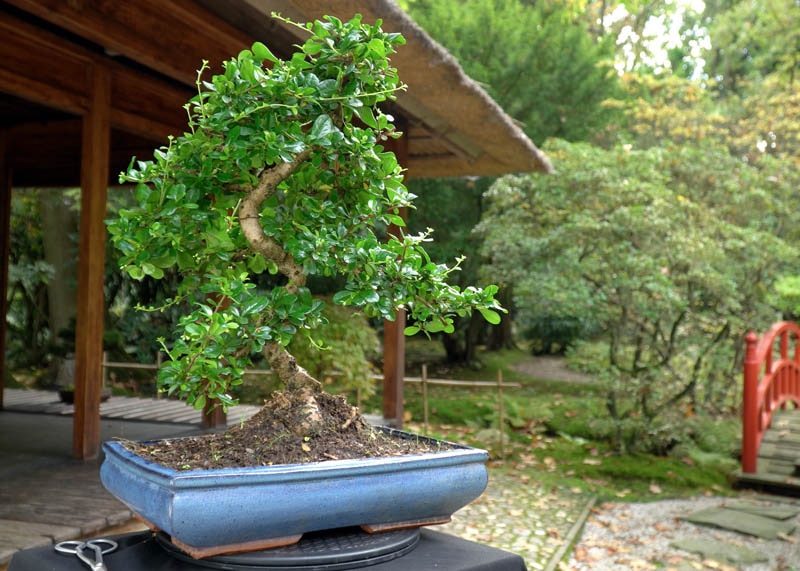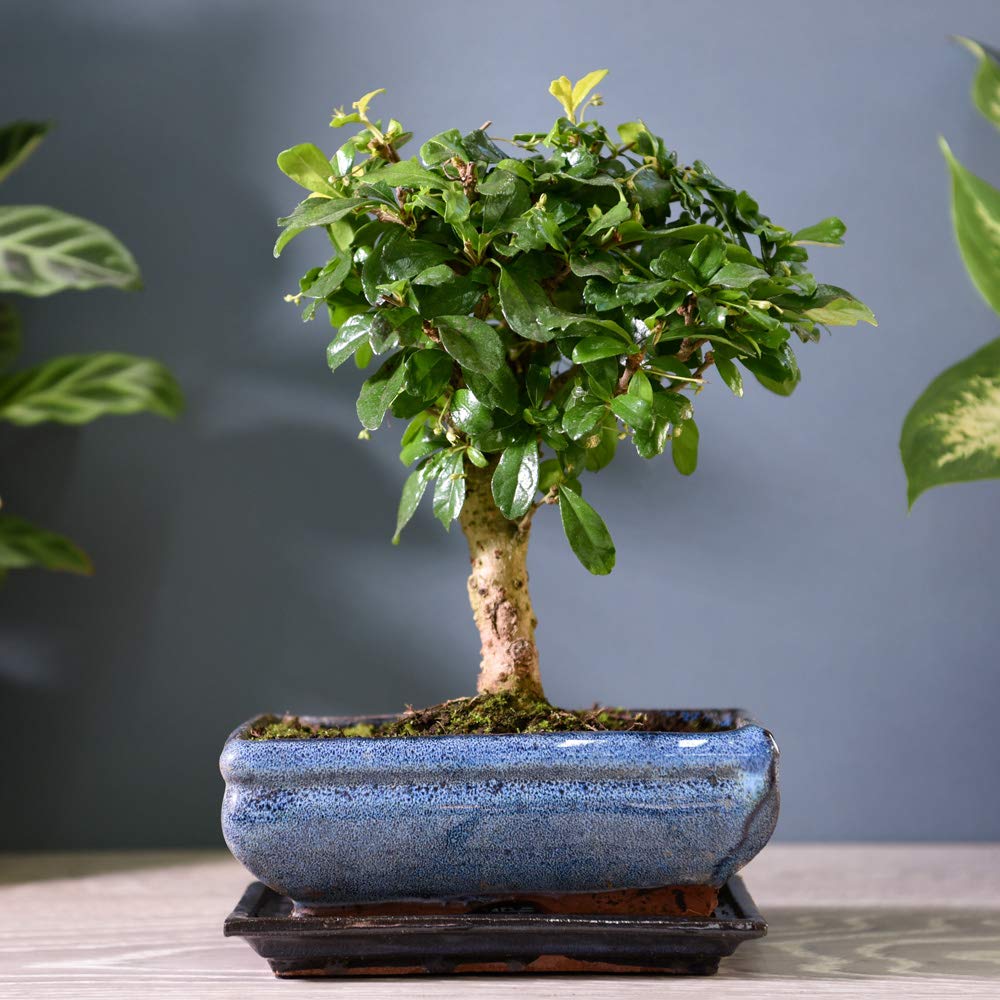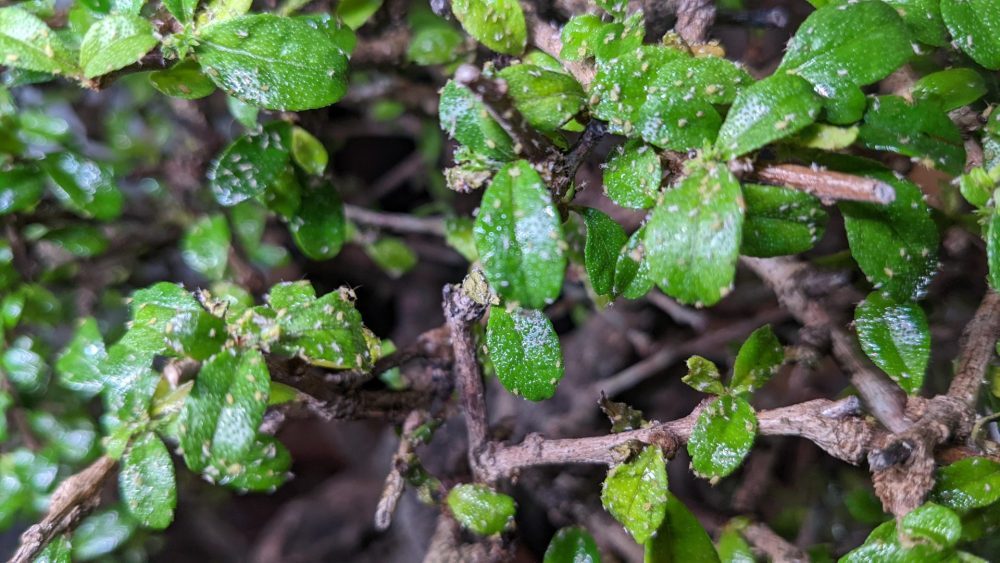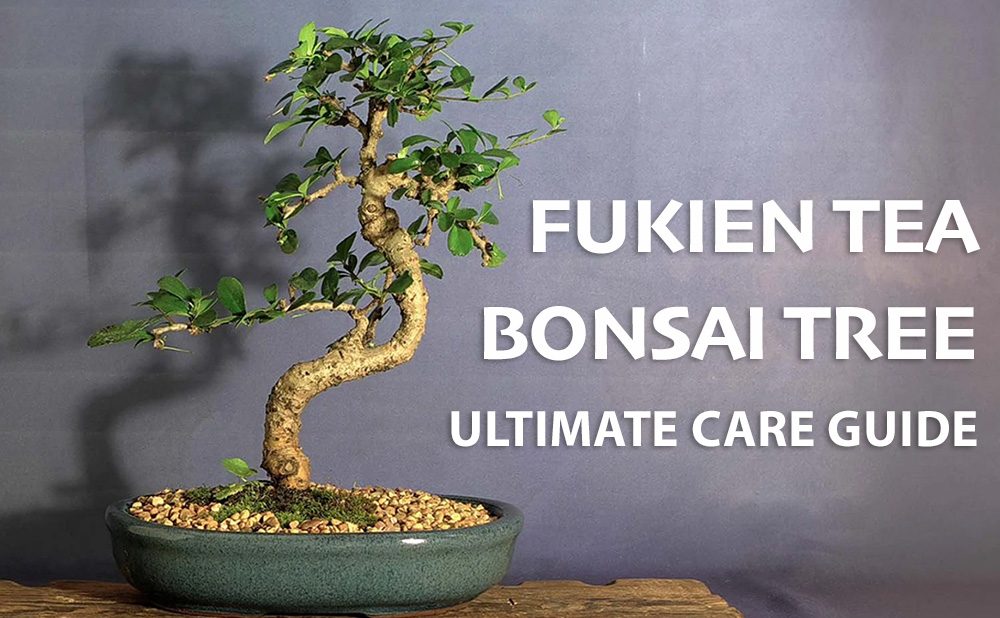- No products in the cart.
What is Fukien Tea Bonsai Tree?
The Fukien tea bonsai tree, also known as Carmona or Philippine tea tree, is a subtropical flowering evergreen shrub native to East Asia and Southeast Asia. Its name, “Fukien,” originates from its place of origin—Fukien or Fujian, China.
In its natural habitat, this tree can grow up to 9.8 feet (3 meters) tall, thriving upright in warm climates.
This tree species is renowned for its knotted trunk and grayish-beige fissured bark, which lend an ancient and dramatic appearance. It also features small, leathery dark green leaves adorned with white dots and fine hairs. Depending on the variety, some leaves may have dented or notched tips.
When grown in favorable conditions, a Fukien tea tree can bloom small, star-shaped white flowers year-round. These flowers form in clusters of 2 to 6 on short stems.
In early summer, these delicate blossoms transform into tiny round berries resembling miniature rosehips. These berries, about 4 to 6 mm in diameter, contain a stone core with up to four seeds. Depending on their age, the berries can appear green, red, or black.

Growing Fukien Tea as Bonsai
The Fukien tea tree is one of China’s most popular penjing specimens and is commonly cultivated as an indoor bonsai in the West for several reasons.
(Note: “Penjing” is the ancient Chinese art from which bonsai art originated.)
Firstly, the Fukien tea, or Carmona bonsai tree, is a fast-growing species that easily develops a thick, knotted trunk, essential for a classic bonsai. Additionally, its small leaves retain their size as they grow and develop fine ramifications.
Compared to other flowering evergreen species, the Fukien tea tree is much easier to train and maintain as bonsai due to its adaptability and low maintenance requirements.
Propagation
You can propagate a Fukien tea tree for bonsai growing between spring and summer using these methods:
- Sowing seeds
- Performing air-layering
- Rooting softwood cuttings
Depending on the method, it can take up to 10 years for your specimen to develop into pre-bonsai material ready for bonsai training.
If you want to practice bonsai cultivation techniques early on, consider buying a young bonsai tree from your local garden center.
How to Care for a Fukien Tea Bonsai Tree
The Fukien tea tree is an easy-to-grow flowering bonsai species, perfect for novice bonsai artists. To grow one successfully, follow this Fukien tea bonsai care guide:
Quick General Care Guide for Fukien Tea Bonsai Trees:
- Positioning: Flourishes indoors in temperate climates and outdoors in warmer climates.
- Watering: Water generously once the soil dries slightly.
- Feeding: Fertilize regularly during the growing season, from spring to autumn.
- Pruning: Prune shoots back to two to three leaves once a year.
- Wiring: Can be wired all year round, ideally after pruning for convenience.
- Repotting: Repot every two years during spring.
- Overwintering: Provide winter protection when temperatures drop below 60°F (15.5°C).
I. Positioning Your Fukien Tea Tree Bonsai
Depending on your region, your Fukien tea tree bonsai can be grown either indoors or outdoors.
Indoor Bonsai in Temperate Climates
- Location: Maintain your Fukien bonsai tea tree indoors where the temperature and humidity levels are higher than those outside.
- Sunlight: Expose your bonsai to at least one hour of direct sunlight daily. Position it near a window that receives natural light, preferably a south-facing one.
- Ideal Temperature: A Carmona bonsai thrives at around 70°F (20°C). If summer temperatures rise to this level or higher, you can temporarily place your tree in a partially shaded outdoor area.

Outdoor Bonsai in Warm Climates
- Location: Fukien tea trees thrive in areas with high temperatures, making them suitable for outdoor growth in very warm climates.
- Sunlight: Position your bonsai outdoors where it can receive adequate sunlight daily, preferably with morning sun and afternoon shade.
- Protection: Protect your tree from direct midday sunlight to avoid leaf burn. If you can’t find a spot with afternoon shade, use a garden screen shade to ensure gentle sunlight exposure on your tree.
II. Watering
A Fukien tea tree does not tolerate prolonged drought or excess wetness. It’s essential to keep the tree moist enough to prevent it from drying out, but not so wet that the roots are waterlogged.
General Watering Rule
Avoid watering on a strict schedule; instead, water based on observation. Only water your bonsai when the soil surface becomes slightly dry.
Seasonal Watering Needs
The water requirements of your Fukien bonsai change with the seasons. Here’s how to adjust your watering routine accordingly:
A. Spring
- Growth Phase: As your bonsai actively grows, its water intake increases. Monitor your tree at least twice daily.
- Watering Technique: Water generously until water runs out of the pot’s drainage holes. Repeat the process to ensure thorough watering.
B. Summer
- Frequency: Water your Fukien bonsai at least twice a day—once in the morning and once in the late afternoon.
- Humidity: Use a humidity tray, especially if the tree is kept indoors, to maintain high humidity around the area. Choose a shallow tray that is slightly wider than your bonsai pot.
- Caution: Avoid overwatering and ensure the tree does not sit in soggy soil, as this can cause root rot.
C. Autumn and Winter
- Reduced Watering: Decrease the frequency of watering to avoid overwatering. Based on the climate, you might only need to water your Carmona bonsai a few times a week or even less often.
III. Fertilizing
To promote the growth of your Carmona bonsai, fertilize it consistently throughout the growing season, from spring through autumn. Given that Fukien tea bonsai plants have sensitive roots, it’s advisable to use slow-release solid fertilizers. Apply the fertilizer to the soil surface and let the roots absorb the nutrients each time you water your tree.
Additionally, you can use liquid fertilizer to encourage root development. However, apply only the recommended amount and ensure the soil is moist to avoid root burn.
Tip: For younger bonsai specimens, choose a high-potassium bonsai fertilizer to encourage stronger and faster growth.
IV. Pruning
Fukien tea bonsai trees respond well to pruning. To promote denser and finer branch ramification, trim your bonsai back to 2 – 3 leaves once each shoot has grown 5 – 8 leaves.. This can be done year-round, though it is most effective during the growing season when other bonsai cultivation techniques are also applied.
Note: Mature branches are hard and brittle. Use appropriate bonsai tools, such as a concave branch cutter, to avoid damaging your tree during pruning.
V. Wiring and Bending
Wiring your tree is essential to maintain its shape and ensure balanced growth, as it helps every part of the tree receive good sunlight. The young shoots of Fukien tea bonsai trees are soft and pliable, making them easier to wire and shape. However, older branches are harder and more brittle, which makes them more susceptible to damage.
Tip: To prevent breaking brittle branches, wrap raffia strips or rubber bands around the area you want to bend. Use aluminum alloy bonsai wire, applying it firmly at a 45-50º angle to provide optimal support.
VI. Repotting Your Fukien Tea Bonsai Tree
The Fukien tea tree is a fast-growing species, requiring regular repotting to prevent excessive root development within the small pot. Generally, repot your Fukien tea tree bonsai every two years or more during spring. You will know it’s time to repot when the roots begin to circle the pot.
If needed, prune the roots to manage the tree’s growth, promote finer root development, and eliminate any roots damaged by root rot. Use a sharp pair of bonsai root scissors to prevent damage to the tree’s delicate root system.
Soil Requirements: Before replanting, use a fresh bonsai soil mixture. Choose well-draining soil with coarse materials such as akadama or pine bark to avoid overwatering.
VII. Winter Care
Fukien bonsai trees thrive in warmer climates and should not be exposed to temperatures below 60°F (15.5°C), as it can be detrimental to their health. In the winter months, shield your bonsai tree from cold or frosty air by relocating it to an unheated space, like a garage or greenhouse. If kept indoors, closing the window may also be necessary.
If you close the window to protect your tree from the cold, use a plant lamp and humidity tray to ensure your tree receives adequate light and moisture throughout the day. Avoid placing it near heating systems, as these appliances produce dry air, reducing the humidity around the tree.
VIII. Pests and Diseases
If not cared for properly, your Fukien bonsai can suffer from various insect infestations, particularly scales, whiteflies, and spider mites. To address these issues, apply the appropriate insecticides at the recommended dosage. However, to prevent infestations, ensure your tree receives the proper amount of natural light and water.

Conclusion
With proper care, the Fukien tea tree bonsai becomes a stunning and elegant plant.. In addition to its dramatic fissured bark, it produces flowers and fruits that add color and life to the tree.
To grow a Fukien tea tree bonsai successfully, familiarize yourself with the basics of bonsai cultivation. With proper care, you can have a beautiful, classic-looking Carmona bonsai tree in no time.
Read more:

